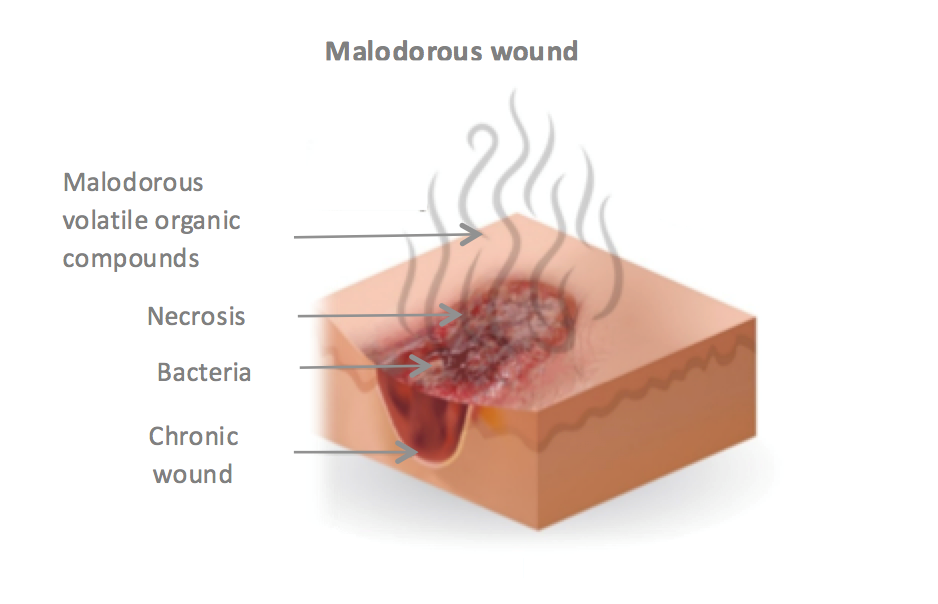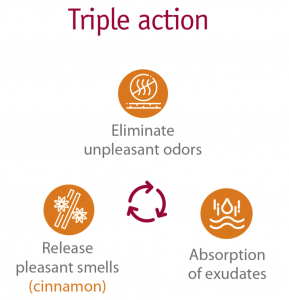Malodourous wounds
Between 5 and 7 million chronic wounds occur in North America each year* About 12 % of malignant wounds are malodorous**
What is a chronic wound?
Wounds have multiple causes from those that are the result of accidents and surgery (acute wounds) to those that are chronic. In a large majority of cases, with an adapted care protocol and factors associated with delayed healing, wound closure and healing takes between several days to several weeks. Nevertheless, in some cases, the wounds do not heal easily and they become chronic. Wounds are considered chronic when healing is not observed after 4 to 6 weeks depending on the cause of the wound. These patients are affected by malignant wounds, infected wounds, ulcers (including “diabetic foot” ulcers),bedsores and tumoral wounds. It is estimated that 10% of chronic wounds are associated with bad odours. These are caused by bacteria present in necrotic tissues which emit malodorous volatile organic components (VOCs). However, bad smells are not always the consequence of an infection but can also be caused by necrotic tissue or bacteria.
Management of chronic malodorous wounds
Chronic wounds are common and are treated in hospitals in several units including surgery, palliative and supportive care eventually with the help of wound care unit. If, despite the care given, the wound cannot heal, odours can be eliminated or reduced in few days by removing necrotic tissue by detersion, by draining abscesses and/or by antibiotic and antimicrobial treatment. Nevertheless, in the case of some very deep lesions, the cause of the odour cannot be treated and the bad smell released by the chronic wound persists. The discomfort experienced by the patient, their close circle and caregivers is enormous. The aim of treatment for these patients is to allow them to regain their self-esteem, to have a social life that is as normal as possible and to improve their quality of life, in particular their quality of sleep and their appetite.
References :
*Sen et al Human Skin Wounds : A major and Snowballing Threat to Public Health and the Economy, Wound repair Regen. 2009 ; **Maida et al. 2009. Symptoms Associated with Malignant Wounds : A Prospective Case Series ; Charitansky H., & Fromatin I. (2008). Les plaies tumorales. Soins, 53 (722), 51-55Mc Manus J., Principles of skin and wound care : the palliative approach, End of life care, 2007, Vol 1., N°1 ; Morris C. Wound odour : principles of management and the use of CliniSorb. Br J Nurs. 2008; 17(6):S38, S40–2 ; O’Brien C. Plaies cancéreuses prise en charge de l’odeur. Canadian Family Physician. mars 2012; vol 58:141-143. English: Malignant wounds: managing odour. Can Fam Physician. 2012; 58(3):272-274. ; Fromantin, I., Watson, S., Baffie, A., & Rivat, A., et al. (2014). A prospective, descriptive cohort study of malignant wound characteristics and wound care strategies in patients with breast cancer. Ostomy Wound Manage 2014 Jun; 6(60):38-48. ; John M.Mac Donald, Terence J.Ryan, Global Impact of the chronic wound and lymphoedema, (2010, World Health Organization report); Nov-Dec.Pansement_synthese_rapport_HAS_2009.
VOC: volatile organic compound
Cinesteam is a secondary anti-odour absorbent dressing manufactured by Cemag Care.
Cinesteam is intended for the management of malodorous wounds.
This medical device (class I) is a regulated healthcare product, which, pursuant to this regulation, bears the CE marking.
Read the leaflet carefully before use.
ML-CIN-FR-1019 created on 10/2019.
